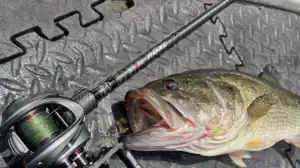Located in northeast Texas, renowned Lake Fork, known for its giant bass, wasn’t even a lake some 60 years ago. So how did it get so good so quick? Wired2fish was lucky enough to spend a day in the boat with Elite Series pro and Lake Fork fishing guide Lee Livesay, where he runs through the history of Lake Fork and how old pond dams impacted and continue to impact the lake today.
Before it was impounded in 1980, Lake Fork Reservoir simply consisted of a creek and hundreds of small ponds. Some natural and some man-made, these small waterbodies served as rearing ponds for Texas Parks and Wildlife, where they stocked and grew hundreds of thousands of Florida-strain largemouth bass. Livesay says that once they raised the lake up, most of these ponds already held largemouth bass up to 14+ pounds. As water levels exceeded the banks of these small ponds, fish were able to roam around throughout the newly made reservoir. What was left behind, however, was hundreds of submerged structures known as pond dams.
Pond dams have served as wonderful habitats for both baitfish and bass for decades now on Lake Fork. Using a variety of electronics, Livesay shows what these pond dams look like underwater and how fish utilize them today. A very unique story of how Lake Fork has grown into one of the biggest bass factories in the world. At the moment, it’s probably the best bass fishing lake in the USA.
ELECTRONICS & BOAT CONTROL
- FISH FINDER – Humminbird HELIX 12 CHIRP MEGA SI+ GPS G4N Buy at Tackle Warehouse
- FORWARD-FACING SONAR (FFS) – Humminbird MEGA Live TargetLock Buy at Tackle Warehouse
- 360 SONAR – Humminbird MEGA 360 Imaging Buy at Tackle Warehouse
- MAPPING – Humminbird LakeMaster With VX Technology, Midsouth States V1 Buy at Tackle Warehouse










